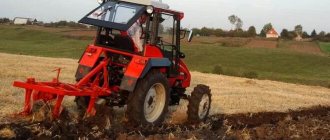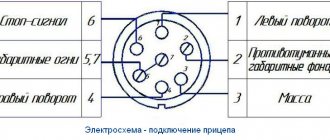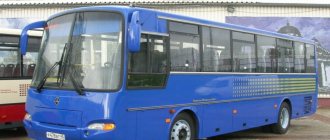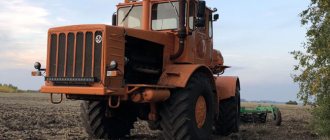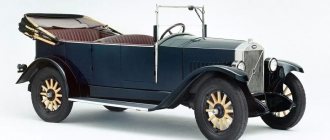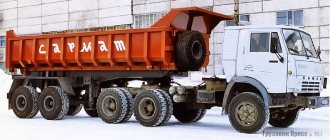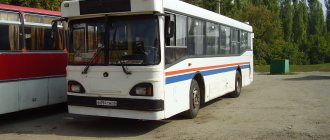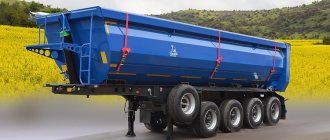| KAVZ LLC | |
| Type | limited liability company |
| Year of foundation | 1958 |
| Former names | Kurgan Bus Plant named after the 60th anniversary of the USSR |
| Location | Russia Russia Kurgan region, Kurgan, st. Avtozavodskaya, 5 k.3 |
| Key figures | Alsaraev, Alexander Viktorovich (Managing Director) |
| Industry | mechanical engineering |
| Products | middle class buses |
| Number of employees | about 400 people (2014) |
| Parent company | GAZ Group |
| Website | [bus.ru/ ] |
Coordinates: 55°25′49″ N. w. 65°16′09″ E. d. / 55.43028° n. w. 65.26917° E. d. / 55.43028; 65.26917 (G) [www.openstreetmap.org/?mlat=55.43028&mlon=65.26917&zoom=12 (O)] (Y)K: Enterprises founded in 1958 KAVZ LLC
(formerly
Kurgan Bus Plant named after the 60th anniversary of the USSR, KAvZ
) is a manufacturer of buses in Russia. Located in the city of Kurgan. Since 2005, it has been part of the Buses Division of the GAZ Group holding, and since 2001, it has been part of the GAZ Group[1].
LLC "KAvZ" is a subsidiary of OJSC "GAZ" (100% share in the authorized capital). The functions of the sole executive body of this company are performed by the management organization - LLC Management Company GAZ Group.
Story
KAvZ-651
Bus KAvZ-3270 in Tomsk
Bus KAVZ-3976 in Tomsk
Bus KaVZ-4235 in Khabarovsk
Initially, since 1953, the plant was built as part of the defense complex. On September 19, 1957, the Order of the Council of Ministers of the RSFSR was issued on the transfer of production of the PAZ-651 bus from the Pavlovsk Bus Plant to Kurgan and the organization of production of hood-type KAVZ-651 buses based on the GAZ-51 car.
On January 14, 1958, the Kurgan Bus Plant produced the first bus. A total of 508 buses were produced in 1958, 1511 in 1959, and 3434 buses in 1960.
In the first 5 years, the plant reaches its design capacity of 5,000 buses per year. In 1962, the plant exceeded its design capacity and produced 5,251 cars. And by 1967, bus manufacturers produced 50,000 base model buses.
Since 1963, a large circulation has been published.
From 1967 to 1977 The plant produces hooded buses KAVZ-685, later renamed KAVZ-3270. Then, with the change in the base truck, the bus model changed accordingly to KAvZ-3976.
In 1986, SPTU-34 was opened at the plant to train workers.
On July 11, 1992, the plant became a joint stock company.
In the 1990s, due to changes in sectors of the national economy, including agriculture, consumer demand for small-capacity buses, the main consumers of which were state farms, collective farms, and state-owned enterprises of line ministries, sharply decreased. A decline in production began: if in 1989 20 thousand buses were produced, then in 1994 - 4 thousand, in 1995 - 1186, in 1997 - 769 cars. Number of employees at KavZ: in 1968 - 1594 people, in 1970 - 2076 people, in 1980 - 3955 people, in 1990 - 4513 people, in 1999 - 3300 people. By 1993, the plant had prepared and organized the production of a new family of modular assembly coach-type buses with a capacity of 24 passengers. places, in a volume of 150-200 pcs. in year. It was here that in 1992 the first carriage-type buses KAvZ-3275, KAvZ-32784, KAvZ-3278 were manufactured, characterized by a higher level of comfort and meeting international safety requirements.
In order to meet the market needs for large-capacity buses, in 1998 technical services developed new models of buses on heavy-duty chassis ZIL-4331 - these are models of city and suburban buses KAvZ-422910, 4229-01. Much attention is also paid to conquering the market for rotational buses. The KAVZ-422990 bus model is being developed on a ZIL all-wheel drive chassis with a 6x6 wheel arrangement. In addition, in 1998, KAVZ returned to the production of rotational vehicles on the URAL chassis, the first batch of which was produced in 1981.
As part of the strategy to bring the enterprise out of a pre-bankruptcy state, in 2001 the Kurgan Bus Plant developed a school bus that most fully meets the GOST requirements for buses for transporting children. The first order for the supply of buses, within the framework of the “School Bus” program, was completed by KAvZ in 2001 in the amount of 55 units for the Yaroslavl region. In the two years since the start of the program, within the framework of the national project “Education,” the Kurgan Bus Plant has manufactured and supplied about 3 thousand school buses to all regions of the Russian Federation. Neighboring countries have also become interested in this solution to the problem of transporting schoolchildren in rural areas. Thus, the first school buses have already been delivered by the Kurgan Bus Plant to the Republic of Belarus, Kazakhstan and Ukraine.
On March 14, 2006, the Kurgan Bus Plant Open Joint Stock Company (TIN 4501022299) ceased operations on the basis of an arbitration court ruling on the completion of bankruptcy proceedings.
KAVZ LLC
On June 19, 2003, KAVZ LLC was created (TIN 4501103580), which became part of the RusPromAvto holding of Oleg Deripaska, who breathed a second life into the plant. In 2005, in connection with the reorganization of RusPromAvto, KAvZ entered the Buses division of the GAZ group, which unites the main manufacturers of buses and automobiles in Russia.
Joining the holding opened up prospects for the plant's production development. The company's management made a strategic decision - to organize the production of middle-class buses PAZ-4230 "Aurora" at the Kurgan Bus Plant. Since 2003, the production of various modifications of these buses has been established at KavZ. An extended version of this bus, the PAZ-4238 Aurora, began to be produced at the Kurgan Bus Plant in 2006, under the designation KAvZ-4238. In 2008, due to tightening environmental standards, the KAVZ-4235 model was developed, which replaced the PAZ-4230 on the production line.
The Kurgan Bus Plant is constantly expanding its geography of supplies not only in Russia and the CIS countries, but also in countries far abroad. From 2009-2011 380 KAVZ buses were delivered to the Republic of Nicaragua, intended to renew the country’s transport fleet.
In 2013, about 600 people worked at the plant[2], in 2014 - about 400 people[3]
Today, the enterprise has all the resources to update production: reconstruction and modernization of process flows are being carried out, the latest equipment with numerical control for processing pipe blanks, and a laser complex for cutting blanks are being purchased.
Modern lineup
At the end of 2007, with the discontinuation of the KavZ-3976 family, the 50-year history of Kurgan bonneted small-class buses on GAZ truck chassis ended. Small-scale production of the half-hood bus KAVZ-3244, carried out by a subsidiary, was discontinued in 2007.
The KAvZ production program for 2009 consisted of rear-engine mid-size buses of the modernized Aurora family KAvZ-4235 and KAvZ-4238 for suburban and inter-district traffic, as well as the urban low-floor midibus KAvZ-4239 on a Chinese chassis.
The plant's model range includes middle-class buses KAvZ-4235 and KAvZ-4238 "Aurora" in urban and suburban, school modifications. In 2010, the Kurgan plant carried out the first stage of restyling of base models. The buses received a modified front mask, a new engine, transmission, and electrical equipment. In 2011, the plant began the second stage - the buses will receive a new interior.
In 2011-2012 the Cummins engine of Euro-4 environmental standard was linked to the plant’s model range.
In market conditions
In 1993, after the reorganization of the enterprise into OJSC Kurgan Bus Plant, a successor was born - KAVZ-39769. The model is distinguished by an extended chassis base (from 3.7 to 4.5 meters) and a noticeable increase in seating capacity (from 21 to 28). There is a 32-seat modification of the KAVZ-39769, based on a 5.4-meter wheelbase. It became the prototype for a school bus with 34 seats. By the way, KAVZ became the first in Russia to receive a license to manufacture specialized school buses.
Unfortunately, the following years became difficult for the company. Previously, the main buyers of buses were collective and state farms. After their disappearance, sales volume decreased significantly. For some time, the plant still produced hooded models for watches, but in 2007 their production was discontinued.
History of hooded KAVZ buses
Half a century since the founding of the enterprise in 1958, KAvZ buses have traditionally been based on extended truck chassis of the Gorky Automobile Plant - without a cab, but retaining the tail of the base trucks. Accordingly, on the GAZ-51A chassis in 1958-1971. the hooded 20-seat KAvZ-651A was produced; in 1971-1984 on the GAZ-53-40 bus chassis - a 21-seater KAVZ-685 bus, rearranged in 1984 on the GAZ-53-12 chassis, and after modernization in 1986, received the KAVZ-3270 index. It was models 685 and 3270 that were the most popular in the history of not only KAvZ, but also the world bus industry, since their annual production volumes in the 70-80s reached 18-20 thousand cars per year (peak in 1989 - 20,008 units) . Since 1989, the basic model of the 20-seater KAVZ-397620 bus was developed on the GAZ-33074 bus chassis. The index of the base model has changed from the second 2 (bus class) to 9 (special vehicle class) to simplify the certification of special versions. Subsequently, based on model 397620, a number of cargo-passenger and special (sanitary, ritual (hearse), operational and service (paddy wagon), etc.) modifications were produced. In 1993, the KAVZ-39765 bus with 28 seats was created on the GAZ-33074 chassis, lengthened in wheelbase from 3700 to 4550 mm. Since 2001, on its basis, according to GOST R51160 “Buses for transporting children,” the KavZ-397653 school bus has been mass-produced. In the experimental series there was an even longer 35-seat modification of the KAvZ-39769, but it never went into production due to problems with the strength of the frame. Also, in 2005-2007, based on the GAZ-3310 Valdai medium-tonnage truck, the hooded KAVZ-32081 Valdai bus was produced in a small series ([fotobus.msk.ru/photo/09/17/76/917762.jpg photo] ). The production volumes of KAvZ buses in the 1990s, compared to the 1970s-80s, decreased by an order of magnitude (~2.0 thousand), approximately to the level of the early 1960s. Therefore, the total production volume of the KAvZ-3976 family cannot be compared with its predecessors. Over half a century, KAvZ produced 0.45 million bonneted buses, which puts it in first place in the world among bus-building companies K: Wikipedia: Articles without sources (type: not specified)[ source not specified 3654 days
].
The production of all KAvZ bonnet buses was discontinued at the end of 2007 due to plans to modernize the enterprise and the transition to the production of fundamentally new products in the form of city mid-size low-floor buses model 4239, made on Chinese units (chassis and power plant). Accordingly, the entire production line for assembling “bonnets” was “completely reconstructed” (sold as scrap metal).
According to an article in the magazine “Autoreview - Trucks and Buses” for 2008, the cost of the latest hooded KAvZ models at the time of production closure was from 525 thousand rubles, which put this bus out of competition with more expensive and lower-quality products of the Chinese automobile industry or containing Chinese components - at the same time, the hoodless KavZ-4239 on a Chinese chassis was already valued at 2.57 million rubles - the price of five bonneted buses.[4]
In 1998-2007 KavZ's subsidiary, Vika LTD LLC, produced the KavZ-3244 small-class bus on a standard ZIL-5301BO chassis with a capacity of 29 passengers (15 seats) with an MMZ D-245 diesel engine with a power of 109 hp. With. with turbocharging. The KavZ-32441 modification with a capacity of 19-22 passengers was also produced on the extended ZIL-5301EO chassis.
KAvZ rotation buses
on the Likhachev Plant and Ural chassis (KAvZ-422990, KAvZ-422991 and KAvZ-42243) were produced in limited series in 1996-2003, but during the restructuring of the enterprise they were reduced as non-core products. The last “shift” of KavZ was in 2004, model 39766 on the all-wheel drive GAZ-3308 “Sadko” chassis.
KAVZ-865
In 1971, the “old man” KAVZ-651 on the assembly line of the Kurgan Bus Plant was replaced by a new 21-seater model - KAVZ-865. It was based on the more progressive chassis of the Gorky Automobile Plant GAZ-53-40. It differed from its predecessor in a more spacious interior, improved design, increased torque, reliability and an increase in the interval between repairs.
These buses can still be found on the roads of the country. Four-ton workers can accelerate to 90 km/h, but the recommended speed is 60 km/h. A significant drawback is the high fuel consumption (24 liters per 100 km). Among the obvious advantages is a heated interior, equipped with soft, comfortable passenger seats.
In 1975, the bus was restyled. In addition to minor technical changes, the appearance has changed slightly. In particular, the round rear brake lights and taillights have been replaced with rectangular ones. The model turned out to be very successful: in 1975 it was awarded the “Quality Mark”. Later (in 1986), improved modifications received the name KAVZ-3270.
Director
- August 20, 1953 - 1961 Klinsky, Viktor Pavlovich
- 1961-1974 Zhuravlev, Gennady Alexandrovich
- 1974—1986 Grishkov, Anatoly Alexandrovich
- 1986—1988 Sobolev, Anatoly Nikolaevich
- 1988-1995 Nazarenko, Viktor Grigorievich
- 1995-1996 Pshenichnikov, Nikolai Dmitrievich
- 1996-1998 Belkov, Sergey Ivanovich
- 1998—2002 Sapozhnikov, Alexander Alekseevich
- 2002-2003 Tikhonenko, Mikhail Andreevich
- June 12, 2004—March 14, 2006 Vadim Pavlovich Soloviev (bankruptcy manager)
- September 27, 2005 - March 1, 2007 Kadylkin, Viktor Sergeevich
- From February 2, 2010 LLC “Managing 2007—2011 Shalaev, Oleg Viktorovich (Managing Director)
- Since 2011 Alsaraev, Alexander Viktorovich (Managing Director, until 2015 - Acting Managing Director)
Factory awards
- In 1973, an experimental batch of the KavZ-3100 urban bus was awarded an Honorary Diploma at the international exhibition "Autoservice-73".
- In 1982, by the Decree of the Presidium of the Supreme Council of the RSFSR, the Kurgan Bus Plant, which had repeatedly taken 1st place among enterprises in its industry, was named after the 60th anniversary of the USSR. The KAVZ-685 M bus was awarded the state Quality Mark.
- In 1994, at the international Moscow exhibition “Motorshow-94”, the KAVZ-3276 bus on a German optimized chassis was awarded the title “Stars of the Salon”.
- In 1995, thanks to the creative work of the plant’s designers, the first Russian “camper” was created on the GAZ-3302 chassis. “Motohata” was a great success at the Moscow “Autosalon-95” and was highly praised by the Minister of Emergency Situations S.K. Shoigu and the President of the Swiss travel company - the customer of this model, Karl Eckstein.
- In 1998, he received the Diploma of the 100 best goods of Russia (KAvZ-3244), Moscow.
- In 1999, he received a Diploma for the best exhibit (KAvZ-32441) at the international exhibition-fair “TransSib-Expo”, Kemerovo.
- In 1999, KAvZ received a III degree diploma and a bronze medal for the development of new types of buses at the Moscow exhibition “Moscow. Regions of Russia" (bus model KAvZ-3244 "Bychok")
- In 1999, the title of Youth Prize Laureate was awarded to the team of Vika LLC for creating the only social taxi in Russia for disabled people (KAvZ-3244 for disabled people).
- In 2002, he received a 1st degree Diploma and a gold medal (KAvZ-39765 “school”) for the best exhibit, exhibition-fair “Expo-Siberia”, Kemerovo.
- In 2010, a bus for transporting children was awarded the “100 Best Products of Russia” sign.
- In 2011, the city low-floor bus was awarded the “100 Best Products of Russia” sign.
KAVZ-3976
In 1989, the Gorky Automobile Plant changed its model range. The place of the outdated GAZ-53 on the assembly line was taken by the GAZ-3307/3309. Accordingly, the Kurgan Bus Plant had to master a new chassis. In the same year, the factory workers presented a more modern model KAVZ-3976. It was produced for almost 10 years.
The 21-seater bus was equipped with a 120/125-horsepower high-torque engine corresponding to the Euro-2 class. There are various modifications:
- passenger;
- cargo-passenger;
- sanitary;
- shift workers;
- paddy wagons;
- hearses.
Notes
- www.dp.ru
[www.dp.ru/nnovgorod/news/auto/2008/01/17/255452/ “KAvZ celebrates its 50th anniversary”] (Russian).
Nizhny Novgorod
(inaccessible link -
history
). Business Petersburg ISSN [www.sigla.ru/table.jsp?f=8&t=3&v0=1606-1829&f=1003&t=1&v1=&f=4&t=2&v2=&f=21&t=3&v3=&f=1016&t=3&v4=&f=1016&t= 3&v5=&bf=4&b=&d=0&ys=&ye=&lng=&ft=&mt=&dt=&vol=&pt=&iss=&ps=&pe=&tr=&tro=&cc=UNION&i=1&v=tagged&s=0&ss=0&st=0&i18n=ru&rlf= &psz=20&bs=20&ce=hJfuypee8JzzufeGmImYYIpZKRJeeOeeWGJIZRrRRrdmtdeee88NJJJJpeeefTJ3peKJJ3UWWPtzzzzzzzzzzzzzzzbzzvzzzpy5zzjzzzzzzzzzzzzzzzzzzzzzzz zzzzzzzztzzzzzzzbzzzzzzzzzzzzzzzzzzzzzzzzzzvzzzzzzyeyTjkDnyHzTuueKZePz9decyzzLzzzL*.c8.NzrGJJvufeeeeeJheeyzjeeeeJh*peeeeKJJJJJJJJJJmjHvOJJJJJJJ JJfeeeieeeeSJJJJJSJJJ3TeIJJJJ3..E.UEAcyhxD.eeeeeeuzzzLJJJJ5.e8JJJheeeeeeeeeeeeeeyeK3JJJJJJJJJ*s7defeeeeeeeeeeeeeeeeeeeeeeeeSJJJJJJJZIJJzzz1..6LJJJJJJtJJZ4….EK *&debug=false 1606-1829] (Online) (13:38; January 17, 2008 of the year). Retrieved January 17, 2008. - [gtrk-kurgan.ru/index.php?option=com_content&view=article&id=4876&catid=23Itemid=120 State Television and Radio Broadcasting Company Kurgan, Nadezhda Efremovtseva: Kurgan Bus Plant is fifty-five.]
- [www.znak.com/2014-10-08/gubernator_kokorin_napravil_srochnoe_pismo_top_menedzheram_v_moskvu_i_nastaivaet_na_vstreche Anastasia Gein. Deripaska's plant in the Trans-Urals is on the verge of closure October 8, 2014]
- [trucks.autoreview.ru/archive/2008/07/kavz/ Farewell to the “kavzik”]
Achievements
For the Kurgan Bus Plant, KAVZ-865 turned out to be a landmark. The bus of this brand became the most popular in the history of the world automotive industry. The company produced tens of thousands of units annually. 1989 turned out to be a record year - this year the factory workers supplied the country with 20,008 units of equipment.
Why is the model popular? First of all, in the unification of the chassis with GAZ-53-40 trucks. Accordingly, there were no problems with finding and replacing spare parts. An important factor was high cross-country ability. In this connection, the main buyers were state farms, collective farms, rotational services, and state-owned enterprises.
Links
Division "Trucks" Automotive | Saransk dump truck plant SAZ Division "Bus" Pavlovsk Bus Plant (PAZ) | Kurgan Bus Plant (KAvZ) Likinsky Bus Plant (LiAZ) | Golitsyn Bus Plant (GolAZ) Division "Power Units" "Avtodiesel" (Yaroslavl Motor Plant, YaMZ) | Yaroslavl Diesel Equipment Plant (YAZDA) | Yaroslavl Fuel Equipment Plant (YAZTA) Division "Automotive components" Gorky Automobile Plant (GAZ) | Plant of stamps and molds | Kanash Automotive Aggregate Plant (KaAZ) Parent company Russian cars Armenia ErAZ¹ Belarus 140th repair plant • AMAZ • Amkodor • BARZ • BelAZ • BelGee • Belkommunmash • GARZ • GZTO¹ • MAZ • MAZ-MAN • MZKT • MoAZ • Neman • Ford Union¹ • Unison¹ Georgia Delta • KAZ¹ • TTRZ Kazakhstan Asia Auto • AgromashHolding • ARKZ¹ • KPI • SaryarkaAvtoProm Kyrgyzstan BASZ • TAvZ² Latvia AMO Plant • Dartz Motorz • Ford-Vairogs² • OSC • RAF¹ • REAF¹ • ROMZ¹ • Russo-Balt¹ • Baltijas Džips Ltd.¹ Lithuania KAG¹ • VFTS¹ Moldova Dnestr-Auto² Russia 101 TsARZ² • 172 TsARZ • AvtoVAZ • AvtoKuban¹ • Automotive special equipment • Avtotor • Alterna • AMZ • AMUR (UAMZ) • Aremkuz¹ • ATUL¹ • BAW-RUS Motor Corporation • BAZ • BZKT • BRMZ² • VIS • VARZ • VZMO² • Volzhanin • GAZ • GZSA • GolAZ • Derways • ElAZ • yo-Avto¹ • ZIL • ZMA • IzhAvto • Izhora plant • IASZ • KATASI¹ • KAVZ • KAMAZ • Komatsu-Rus • KZKT¹ • Krasny Putilovets • Lesselmash² • LiAZ • MADI • MARZ • Marusya Motors¹ • MZSA • MMZ • Moskvich¹ • NAMI • NefAZ • OZTP • PAZ • Pskovavto • Renault Russia • RIAT² • RoAZ² • RAZZ • RosLada • RMZ • SAZ • SeAZ² • SemAR • Sollers • TagAZ • Tonar • TMZ • UAZ • UralAZ • Uralets² • TsARM¹ • ChebARZ • Chechenavto • YaMZ • Yarovit Tajikistan CHAZ² • Khujand-ZIL² Turkmenistan not available Uzbekistan GM Powertrans Uzbekistan • GM Uzbekistan • GM Uzbekistan Khorezm • Land Rover Uzbekistan¹ • MAN Auto-Uzbekistan • Ravon • SamAuto • UzAutoSanoat • UzDaewoo² Ukraine Aviakon² • Avtomash² • Automotive equipment • Autotechnology • Anto-Rus¹ • Bogdan • BAZ • VEPR • Vipos² • VOEZ² • GalAZ • GARZ • DAB² • DAZ • Dobrota² • DUAC • EARZ² • Eurocar • ZAZ • ZLK • ZhBTZ • ZEZTS² • IVECO-Motor Sich² • IVECO-Ukraine² • ISAA² • KamMotor¹ • KARZ MOU² • KBTZ • KZET² • KMZ² • KrAZ • KrASZ¹ • LAZ² • LASZ¹ • LBTZ • LuAZ • LEK¹ • MeMZ • NBTZ • OdAZ¹ • Practice • Reform • SARB² • SBM • SZ M² • Skif¹ • SKEM • Stasyulevich¹ • Stry Avto² • Ukravtobusprom • Ukrainian armored vehicles • Foton¹ • HADI • HASZ¹ • KHARZ • KhZSM • KhZTM • KHKBM • Cherkasy bus • CHAZ² • ChZSA² • ChRZ² • Elektrontrans • YuMZ² Estonia Combat Armoring Group • Esttec¹ • TARK¹ • TARTS² • VIHUR¹ ¹ do not function, ² car production has ceased
An excerpt characterizing the Kurgan Bus Plant
- To His Majesty with an errand. - Here he is! - said Boris, who heard that Rostov needed His Highness, instead of His Majesty. And he pointed him to the Grand Duke, who, a hundred paces away from them, in a helmet and a cavalry guard's tunic, with his raised shoulders and frowning eyebrows, was shouting something to the white and pale Austrian officer. “But this is the Grand Duke, and I’m going to the commander-in-chief or the sovereign,” said Rostov and started to move his horse. - Count, count! - shouted Berg, as animated as Boris, running up from the other side, - Count, I was wounded in my right hand (he said, showing his hand, bloody, tied with a handkerchief) and remained in the front. Count, holding a sword in my left hand: in our race, the von Bergs, Count, were all knights. Berg said something else, but Rostov, without listening to him, had already moved on. Having passed the guards and an empty gap, Rostov, in order not to fall into the first line again, as he came under attack by the cavalry guards, rode along the line of reserves, going far around the place where the hottest shooting and cannonade was heard. Suddenly, in front of him and behind our troops, in a place where he could not possibly suspect the enemy, he heard close rifle fire. "What could it be? - thought Rostov. - Is the enemy behind our troops? It can’t be, Rostov thought, and a horror of fear for himself and for the outcome of the entire battle suddenly came over him. “Whatever it is, however,” he thought, “there’s nothing to go around now.” I must look for the commander-in-chief here, and if everything is lost, then it’s my job to perish along with everyone else.” The bad feeling that suddenly came over Rostov was confirmed more and more the further he drove into the space occupied by crowds of heterogeneous troops, located beyond the village of Prats. - What's happened? What's happened? Who are they shooting at? Who's shooting? - Rostov asked, matching the Russian and Austrian soldiers running in mixed crowds across his road. - The devil knows them? Beat everyone! Get lost! - the crowds of people running and not understanding, just like him, what was happening here, answered him in Russian, German and Czech. - Beat the Germans! - one shouted. - Damn them - traitors. “Zum Henker diese Ruesen... [To hell with these Russians...],” the German grumbled something. Several wounded were walking along the road. Curses, screams, moans merged into one common roar. The shooting died down and, as Rostov later learned, Russian and Austrian soldiers were shooting at each other. "My God! what is this? - thought Rostov. - And here, where the sovereign can see them at any moment... But no, these are probably just a few scoundrels. This will pass, this is not it, this cannot be, he thought. “Just hurry up, pass them quickly!” The thought of defeat and flight could not enter Rostov’s head. Although he saw French guns and troops precisely on Pratsenskaya Mountain, on the very one where he was ordered to look for the commander-in-chief, he could not and did not want to believe it. Near the village of Praca, Rostov was ordered to look for Kutuzov and the sovereign. But here not only were they not there, but there was not a single commander, but there were heterogeneous crowds of frustrated troops. He urged his already tired horse to get through these crowds as quickly as possible, but the further he moved, the more upset the crowds became. The high road on which he drove out was crowded with carriages, carriages of all kinds, Russian and Austrian soldiers, of all branches of the military, wounded and unwounded. All this hummed and swarmed in a mixed manner to the gloomy sound of flying cannonballs from the French batteries placed on the Pratsen Heights. - Where is the sovereign? where is Kutuzov? - Rostov asked everyone he could stop, and could not get an answer from anyone. Finally, grabbing the soldier by the collar, he forced him to answer himself. - Eh! Brother! Everyone has been there for a long time, they ran away! - the soldier said to Rostov, laughing at something and breaking free. Leaving this soldier, who was obviously drunk, Rostov stopped the horse of the orderly or the guard of an important person and began to question him. The orderly announced to Rostov that an hour ago the sovereign had been driven at full speed in a carriage along this very road, and that the sovereign was dangerously wounded. “It can’t be,” said Rostov, “that’s right, someone else.” “I saw it myself,” said the orderly with a self-confident grin. “It’s time for me to know the sovereign: it seems like how many times in St. Petersburg I’ve seen something like this.” A pale, very pale man sits in a carriage. As soon as the four blacks let loose, my fathers, he thundered past us: it’s time, it seems, to know both the royal horses and Ilya Ivanovich; It seems that the coachman does not ride with anyone else like the Tsar. Rostov let his horse go and wanted to ride on. A wounded officer walking past turned to him. -Who do you want? – asked the officer. - Commander-in-Chief? So he was killed by a cannonball, killed in the chest by our regiment. “Not killed, wounded,” another officer corrected. - Who? Kutuzov? - asked Rostov. - Not Kutuzov, but whatever you call him - well, it’s all the same, there aren’t many alive left. Go over there, to that village, all the authorities have gathered there,” said this officer, pointing to the village of Gostieradek, and walked past. Rostov rode at a pace, not knowing why or to whom he would go now. The Emperor is wounded, the battle is lost. It was impossible not to believe it now. Rostov drove in the direction that was shown to him and in which a tower and a church could be seen in the distance. What was his hurry? What could he now say to the sovereign or Kutuzov, even if they were alive and not wounded? “Go this way, your honor, and here they will kill you,” the soldier shouted to him. - They'll kill you here! - ABOUT! what are you saying! said another. -Where will he go? It's closer here. Rostov thought about it and drove exactly in the direction where he was told that he would be killed. “Now it doesn’t matter: if the sovereign is wounded, should I really take care of myself?” he thought. He entered the space where most of the people fleeing from Pratsen died. The French had not yet occupied this place, and the Russians, those who were alive or wounded, had long abandoned it. On the field, like heaps of good arable land, lay ten people, fifteen killed and wounded on every tithe of space. The wounded crawled down in twos and threes together, and one could hear their unpleasant, sometimes feigned, as it seemed to Rostov, screams and moans. Rostov started to trot his horse so as not to see all these suffering people, and he became scared. He feared not for his life, but for the courage that he needed and which, he knew, would not withstand the sight of these unfortunates. The French, who stopped shooting at this field strewn with the dead and wounded, because there was no one alive on it, saw the adjutant riding along it, aimed a gun at him and threw several cannonballs. The feeling of these whistling, terrible sounds and the surrounding dead people merged for Rostov into one impression of horror and self-pity. He remembered his mother's last letter. “What would she feel,” he thought, “if she saw me now here, on this field and with guns pointed at me.” In the village of Gostieradeke there were, although confused, but in greater order, Russian troops marching away from the battlefield. The French cannonballs could no longer reach here, and the sounds of firing seemed distant. Here everyone already saw clearly and said that the battle was lost. Whoever Rostov turned to, no one could tell him where the sovereign was, or where Kutuzov was. Some said that the rumor about the sovereign’s wound was true, others said that it was not, and explained this false rumor that had spread by the fact that, indeed, the pale and frightened Chief Marshal Count Tolstoy galloped back from the battlefield in the sovereign’s carriage, who rode out with others in the emperor’s retinue on the battlefield. One officer told Rostov that beyond the village, to the left, he saw someone from the higher authorities, and Rostov went there, no longer hoping to find anyone, but only to clear his conscience before himself. Having traveled about three miles and having passed the last Russian troops, near a vegetable garden dug in by a ditch, Rostov saw two horsemen standing opposite the ditch. One, with a white plume on his hat, seemed familiar to Rostov for some reason; another, unfamiliar rider, on a beautiful red horse (this horse seemed familiar to Rostov) rode up to the ditch, pushed the horse with his spurs and, releasing the reins, easily jumped over the ditch in the garden. Only the earth crumbled from the embankment from the horse’s hind hooves. Turning his horse sharply, he again jumped back over the ditch and respectfully addressed the rider with the white plume, apparently inviting him to do the same. The horseman, whose figure seemed familiar to Rostov and for some reason involuntarily attracted his attention, made a negative gesture with his head and hand, and by this gesture Rostov instantly recognized his lamented, adored sovereign. “But it couldn’t be him, alone in the middle of this empty field,” thought Rostov. At this time, Alexander turned his head, and Rostov saw his favorite features so vividly etched in his memory. The Emperor was pale, his cheeks were sunken and his eyes sunken; but there was even more charm and meekness in his features. Rostov was happy, convinced that the rumor about the sovereign’s wound was unfair. He was happy that he saw him. He knew that he could, even had to, directly turn to him and convey what he was ordered to convey from Dolgorukov. But just as a young man in love trembles and faints, not daring to say what he dreams of at night, and looks around in fear, looking for help or the possibility of delay and escape, when the desired moment has come and he stands alone with her, so Rostov now, having achieved that , what he wanted more than anything in the world, did not know how to approach the sovereign, and he was presented with thousands of reasons why it was inconvenient, indecent and impossible. "How! I seem to be glad to take advantage of the fact that he is alone and despondent. An unknown face may seem unpleasant and difficult to him at this moment of sadness; Then what can I tell him now, when just looking at him my heart skips a beat and my mouth goes dry?” Not one of those countless speeches that he, addressing the sovereign, composed in his imagination, came to his mind now. Those speeches were mostly held under completely different conditions, they were spoken for the most part at the moment of victories and triumphs and mainly on his deathbed from his wounds, while the sovereign thanked him for his heroic deeds, and he, dying, expressed his love confirmed in fact my. “Then why should I ask the sovereign about his orders to the right flank, when it is already 4 o’clock in the evening and the battle is lost? No, I definitely shouldn’t approach him. Shouldn't disturb his reverie. It’s better to die a thousand times than to receive a bad look from him, a bad opinion,” Rostov decided and with sadness and despair in his heart he drove away, constantly looking back at the sovereign, who was still standing in the same position of indecisiveness. While Rostov was making these considerations and sadly driving away from the sovereign, Captain von Toll accidentally drove into the same place and, seeing the sovereign, drove straight up to him, offered him his services and helped him cross the ditch on foot. The Emperor, wanting to rest and feeling unwell, sat down under an apple tree, and Tol stopped next to him. From afar, Rostov saw with envy and remorse how von Tol spoke to the sovereign for a long time and with fervor, and how the sovereign, apparently crying, closed his eyes with his hand and shook hands with Tol. “And I could be in his place?” Rostov thought to himself and, barely holding back tears of regret for the fate of the sovereign, in complete despair he drove on, not knowing where and why he was going now. His despair was the greater because he felt that his own weakness was the cause of his grief. He could... not only could, but he had to drive up to the sovereign. And this was the only opportunity to show the sovereign his devotion. And he didn’t use it... “What have I done?” he thought. And he turned his horse and galloped back to the place where he had seen the emperor; but there was no one behind the ditch anymore. Only carts and carriages were driving. From one furman, Rostov learned that the Kutuzov headquarters was located nearby in the village where the convoys were going. Rostov went after them. The guard Kutuzov walked ahead of him, leading horses in blankets. Behind the bereytor there was a cart, and behind the cart walked an old servant, in a cap, a sheepskin coat and with bowed legs. - Titus, oh Titus! - said the bereitor. - What? - the old man answered absentmindedly. - Titus! Go threshing. - Eh, fool, ugh! – the old man said, spitting angrily. Some time passed in silent movement, and the same joke was repeated again. At five o'clock in the evening the battle was lost at all points. More than a hundred guns were already in the hands of the French. Przhebyshevsky and his corps laid down their weapons. Other columns, having lost about half of the people, retreated in frustrated, mixed crowds. The remnants of the troops of Lanzheron and Dokhturov, mingled, crowded around the ponds on the dams and banks near the village of Augesta. At 6 o'clock only at the Augesta dam the hot cannonade of the French alone could still be heard, who had built numerous batteries on the descent of the Pratsen Heights and were hitting our retreating troops. In the rearguard, Dokhturov and others, gathering battalions, fired back at the French cavalry that was pursuing ours. It was starting to get dark. On the narrow dam of Augest, on which for so many years the old miller sat peacefully in a cap with fishing rods, while his grandson, rolling up his shirt sleeves, was sorting out silver quivering fish in a watering can; on this dam, along which for so many years the Moravians drove peacefully on their twin carts loaded with wheat, in shaggy hats and blue jackets and, dusted with flour, with white carts leaving along the same dam - on this narrow dam now between wagons and cannons, under the horses and between the wheels crowded people disfigured by the fear of death, crushing each other, dying, walking over the dying and killing each other only so that, after walking a few steps, to be sure. also killed. Every ten seconds, pumping up the air, a cannonball splashed or a grenade exploded in the middle of this dense crowd, killing and sprinkling blood on those who stood close. Dolokhov, wounded in the arm, on foot with a dozen soldiers of his company (he was already an officer) and his regimental commander, on horseback, represented the remnants of the entire regiment. Drawn by the crowd, they pressed into the entrance to the dam and, pressed on all sides, stopped because a horse in front fell under a cannon, and the crowd was pulling it out. One cannonball killed someone behind them, the other hit in front and splashed Dolokhov’s blood. The crowd moved desperately, shrank, moved a few steps and stopped again. Walk these hundred steps, and you will probably be saved; stand for another two minutes, and everyone probably thought he was dead. Dolokhov, standing in the middle of the crowd, rushed to the edge of the dam, knocking down two soldiers, and fled onto the slippery ice that covered the pond. “Turn,” he shouted, jumping on the ice that was cracking under him, “turn!” - he shouted at the gun. - It’s holding!... The ice was holding it, but it was bending and cracking, and it was obvious that not only under a gun or a crowd of people, but under him alone, it would now collapse. They looked at him and huddled close to the shore, not daring to step on the ice yet. The regiment commander, standing on horseback at the entrance, raised his hand and opened his mouth, addressing Dolokhov. Suddenly one of the cannonballs whistled so low over the crowd that everyone bent down. Something splashed into the wet water, and the general and his horse fell into a pool of blood. No one looked at the general, no one thought to raise him.



